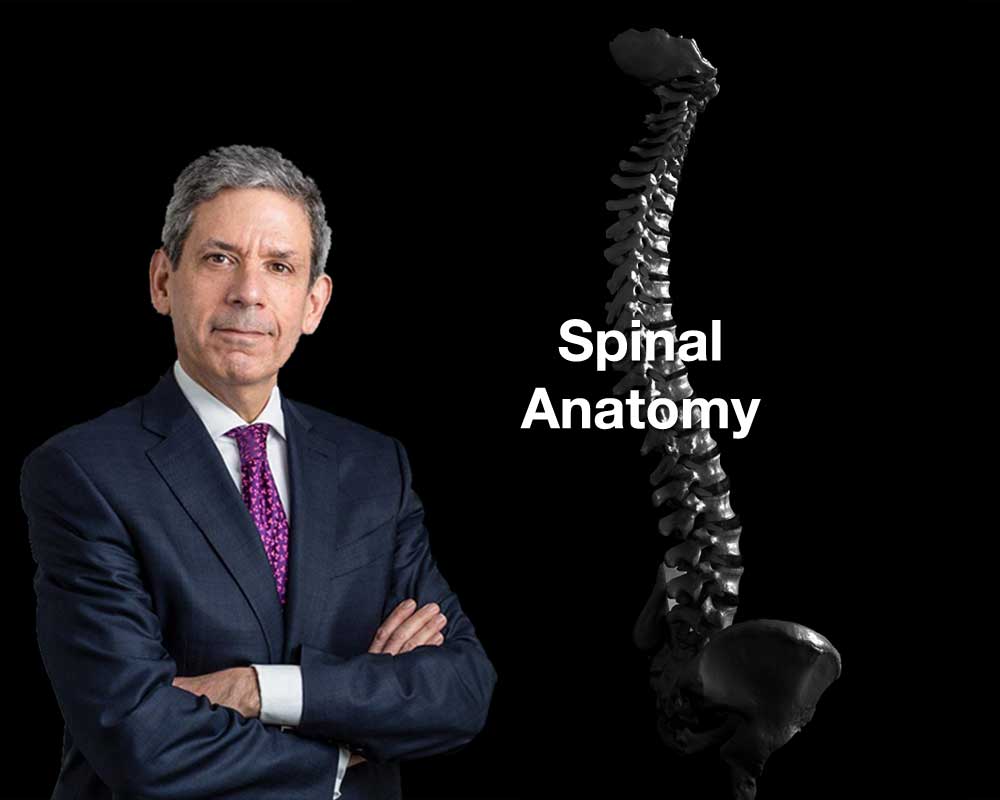
Spinal Anatomy
Understanding your spinal anatomy will make it easier to understand the objectives and goals of your spine surgery.
A basic understanding of the spine's anatomy and its functions is extremely important for patients with spinal disorders. This article provides a straightforward overview of the spine's remarkable and complex anatomy. It begins by providing a "big picture" of the functions of the spine, its regions, and major curves. This is followed by detailed information on specific anatomic elements such as vertebral structures, intervertebral discs, the spinal cord and nerve roots, joints, muscles and ligaments.
Functions of the Spine
The three main functions of the spine are to:
- Protect the spinal cord, nerve roots and several of the body's internal organs.
- Provide structural support and balance to maintain an upright posture.
- Enable flexible motion.
Regions of the Spine
Typically, the spine is divided into four main regions: cervical, thoracic, lumbar and sacral. Each region has specific characteristics and functions.
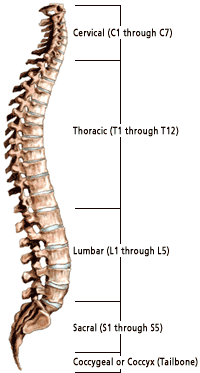
Cervical Spine
The neck region of the spine is known as the Cervical Spine. This region consists of seven vertebrae, which are abbreviated C1 through C7 (top to bottom). These vertebrae protect the brain stem and the spinal cord, support the skull, and allow for a wide range of head movement.
The first cervical vertebra (C1) is called the Atlas. The Atlas is ring-shaped and it supports the skull. C2 is called the Axis. It is circular in shape with a blunt peg-like structure (called the Odontoid Process or "dens") that projects upward into the ring of the Atlas. Together, the Atlas and Axis enable the head to rotate and turn. The other cervical vertebrae (C3 through C7) are shaped like boxes with small spinous processes (finger-like projections) that extend from the back of the vertebrae.
Thoracic Spine
Beneath the last cervical vertebra are the 12 vertebrae of the Thoracic Spine. These are abbreviated T1 through T12 (top to bottom). T1 is the smallest and T12 is the largest thoracic vertebra. The thoracic vertebrae are larger than the cervical bones and have longer spinous processes.
In addition to longer spinous processes, rib attachments add to the thoracic spine's strength. These structures make the thoracic spine more stable than the cervical or lumbar regions. In addition, the rib cage and ligament systems limit the thoracic spine's range of motion and protect many vital organs.
Lumbar Spine
The Lumbar Spine has 5 vertebrae abbreviated L1 through L5 (largest). The size and shape of each lumbar vertebra is designed to carry most of the body's weight. Each structural element of a lumbar vertebra is bigger, wider and broader than similar components in the cervical and thoracic regions.
The lumbar spine has more range of motion than the thoracic spine, but less than the cervical spine. The lumbar facet joints allow for significant flexion and extension movement but limit rotation.
Sacral Spine
The Sacrum is located behind the pelvis. Five bones (abbreviated S1 through S5) fused into a triangular shape, form the sacrum. The sacrum fits between the two hipbones connecting the spine to the pelvis. The last lumbar vertebra (L5) articulates (moves) with the sacrum. Immediately below the sacrum are five additional bones, fused together to form the Coccyx (tailbone).
The Pelvis and the Skull
Although not typically viewed as part of the spine, the pelvis and the skull are anatomic structures that closely inter-relate with the spine, and have a significant impact on the patient’s balance.
Spinal Planes
To help further understand and describe the anatomy, spine surgeons often refer to specific body planes. A body plane is an imaginary flat, two-dimensional surface that is used to define a particular area of anatomy.
Table 1
| Term | Meaning |
| Frontal or Coronal Plane | Divides the front and back halves of the entire body. |
| Median or Sagittal Plane | Divides the left and right sides of the entire body. |
| Transverse or Axial Plane | Divides the body at the waist (top and bottom halves of the body). |
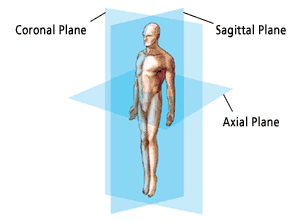
Spinal Curves
When viewed from the front (Coronal Plane) the healthy spine is straight. (A sideways curve in the spine is known as scoliosis.) When viewed from the side (Sagittal Plane) the mature spine has four distinct curves. These curves are described as being either kyphotic or lordotic.
A kyphotic curve is a convex curve in the spine (i.e. convexity towards the back of the spine). The curves in the thoracic and sacral spine are kyphotic.
A lordotic curve is concave (i.e. concavity towards the back of the spine), and is found in the cervical and lumbar levels of the spine.
Vertebral Structures
All vertebrae consist of the same basic elements, with the exception of the first two cervical vertebrae.
The outer shell of a vertebra is made of cortical bone. This type of bone is dense, solid and strong. Inside each vertebra is cancellous bone, which is weaker than cortical bone and consists of loosely knit structures that look somewhat like a honeycomb. Bone marrow, which forms red blood cells and some types of white blood cells, is found within the cavities of cancellous bone.
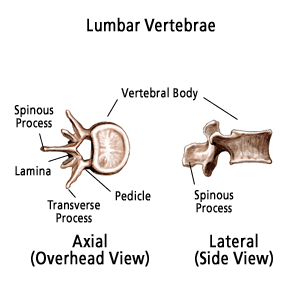
Vertebrae consist of the following common elements:
- Verterbral Body: The largest part of a vertebra. If looked at from above it generally has a somewhat oval shape. When looked at from the side, the vertebral body is shaped like an hourglass, being thicker at the ends and thinner in the middle. The body is covered with strong cortical bone, with cancellous bone within.
- Pedicles: These are two short processes, made of strong cortical bone, that protrude from the back of the vertebral body.
- Laminae: Two relatively flat plates of bone that extend from the pedicles on either side and join in the midline.
- Processes: There are three types of processes: articular, transverse and spinous. The processes serve as connection points for ligaments and tendons.
The 4 articular processes link with the articular processes of adjacent vertebrae to form the facet joints. The facet joints, combined with the intervertebral discs, allows for motion in the spine.
The spinous process extends posteriorly from the point where the two laminae join, and acts as a lever to effect motion of the vertebra.
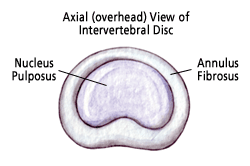
- Endplates: The top (superior) and bottom (inferior) of each vertebral body is “coated” with an endplate. Endplates are complex structures that “blend” into the intervertebral disc and help support the disc.
- Intervertebral Foramen: The pedicles have a small notch on their upper surface and a deep notch on their bottom surface. When the vertebrae are stacked on top of each other the pedicle notches form an area called the intervertebral foramen. This area is of critical importance as the nerve roots exit from the spinal cord through this area to the rest of the body.
Facet Joints
The joints in the spinal column are located posterior to the vertebral body (on the backside). These joints help the spine to bend, twist, and extend in different directions. Although these joints enable movement, they also restrict excessive movement such as hyperextension and hyper-flexion (i.e. whiplash).
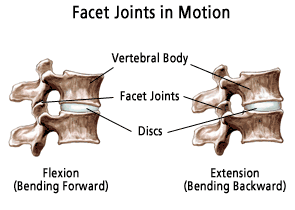
Each vertebra has two facet joints. The superior articular facet faces upward and works like a hinge with the inferior articular facet (below).
Like other joints in the body, each facet joint is surrounded by a capsule of connective tissue and produces synovial fluid to nourish and lubricate the joint. The surfaces of the joint are coated with cartilage that helps each joint to move (articulate) smoothly.
Intervertebral Discs
Between each vertebral body is a "cushion" called an intervertebral disc. Each disc absorbs the stress and shock the body incurs during movement and prevents the vertebrae from grinding against one another. The intervertebral discs are the largest structures in the body without a vascular supply. Through osmosis, each disc absorbs needed nutrients.

Each disc is made up of two parts: the annulus fibrosis and the nucleus pulposus.
Annulus Fibrosus
The annulus is a sturdy tire-like structure that encases a gel-like center, the nucleus pulposus. The annulus enhances the spine’s rotational stability and helps to resist compressive stress.
The annulus consists of water and layers of sturdy elastic collagen fibers. The fibers are oriented at different angles horizontally similar to the construction of a radial tire. Collagen gains its strength from strong fibrous bundles of protein that are linked together.
Nucleus Pulposus
The center portion of each intervertebral disc is a filled with a gel-like elastic substance. Together with the annulus fibrosus, the nucleus pulposus transmits stress and weight from vertebra to vertebra.Like the annulus fibrosus, the nucleus pulposus consists of water, collagen and proteoglycans. However, the proportion of these substances in the nucleus pulposus is different. The nucleus contains more water than the annulus.
The Spinal Cord and Nerve Roots
The spinal cord is a slender cylindrical structure about the width of the little finger. The spinal cord begins immediately below the brain stem and extends to the first lumbar vertebra (L1). Thereafter, the cord blends with the conus medullaris that becomes the cauda equina, a group of nerves resembling the tail of a horse. The spinal nerve roots are responsible for stimulating movement and feeling. The nerve roots exit the spinal canal through the intervertebral foramen, small openings between each vertebra.

The brain and the spinal cord make up the Central Nervous System (CNS). The nerve roots that exit the spinal cord/spinal canal branch out into the body to form the Peripheral Nervous System (PNS).
Between the front and back portions of the vertebra (i.e. the mid-region) is the spinal canal that houses the spinal cord and the intervertebral foramen. The foramen are small openings formed between each vertebra. These “holes” provide space for the nerve roots to exit the spinal canal and to further branch out to form the peripheral nervous system.
| Type of Neural Structure | Role/Function |
| Brain Stem | Connects the spinal cord to other parts of the brain. |
| Spinal Cord | Carries nerve impulses between the brain and spinal nerves. |
| Cervical Nerves (8 pairs) | These nerves supply the head, neck, shoulders, arms, and hands. |
| Thoracic Nerves (12 pairs) | Connects portions of the upper abdomen and muscles in the back and chest areas. |
| Lumbar Nerves (5 pairs) | Feeds the lower back and legs. |
| Sacral Nerves (5 pairs) | Supplies the buttocks, legs, feet, anal and genital areas of the body. |
| Dermatomes | Areas on the skin surface supplied by nerve fibers from one spinal root. |
Ligaments, Muscles and Tendons
Ligaments
Ligaments and tendons are fibrous bands of connective tissue that attach to bone. Ligaments connect two or more bones together and also help to stabilize joints. Tendons attach muscle to bone. They vary in size and are somewhat elastic.
The system of ligaments in the vertebral column, combined with the tendons and muscles, provides a natural type of brace to help protect the spine from injury. Ligaments keep a joint stable during rest and movement. Further, ligaments help to prevent injury from hyper- extension and flexion movements.
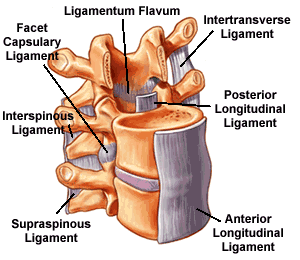
Table 3
| Ligament Name | Description |
| Anterior Longitudinal Ligament (ALL) A primary spine stabilizer |
About one inch wide, the ALL runs the entire length of the spine from the base of the skull to the sacrum. It connects the front (anterior) of the vertebral body to the front of the annulus fibrosis. |
| Posterior Longitudinal Ligament (PLL) A primary spine stabilizer |
About one inch wide, the PLL runs the entire length of the spine from the base of the skull to sacrum. It connects the back (posterior) of the vertebral body to the back of the annulus fibrosis. |
| Supraspinous Ligament | This ligament attaches the tip of each spinous process to the other. |
| Interspinous Ligament | This thin ligament attaches to another ligament, called the ligamentum flavum, that runs deep into the spinal column. |
| Ligamentum Flavum The strongest ligament |
This yellow ligament is the strongest one. It runs from the base of the skull to the pelvis, in front of and behind the lamina, and protects the spinal cord and nerves. The ligamentum flavum also surrounds the facet joint capsules. |
Muscles and Tendons
The muscular system of the spine is complex, with several different muscles playing important roles. The primary function of the muscles is to support and stabilize the spine. Specific muscles are associated with movement of parts of the anatomy. For example, the Sternocleidomastoid muscle assists with movement of the head, while the Psoas Major muscle is associated with flexion of the thigh.
Muscles, either individually or in groups, are supported by fascia. Fascia is strong connective tissue. The tendon that attaches muscle to bone is part of the fascia. The muscles in the vertebral column are called flexors, rotators, or extensors.